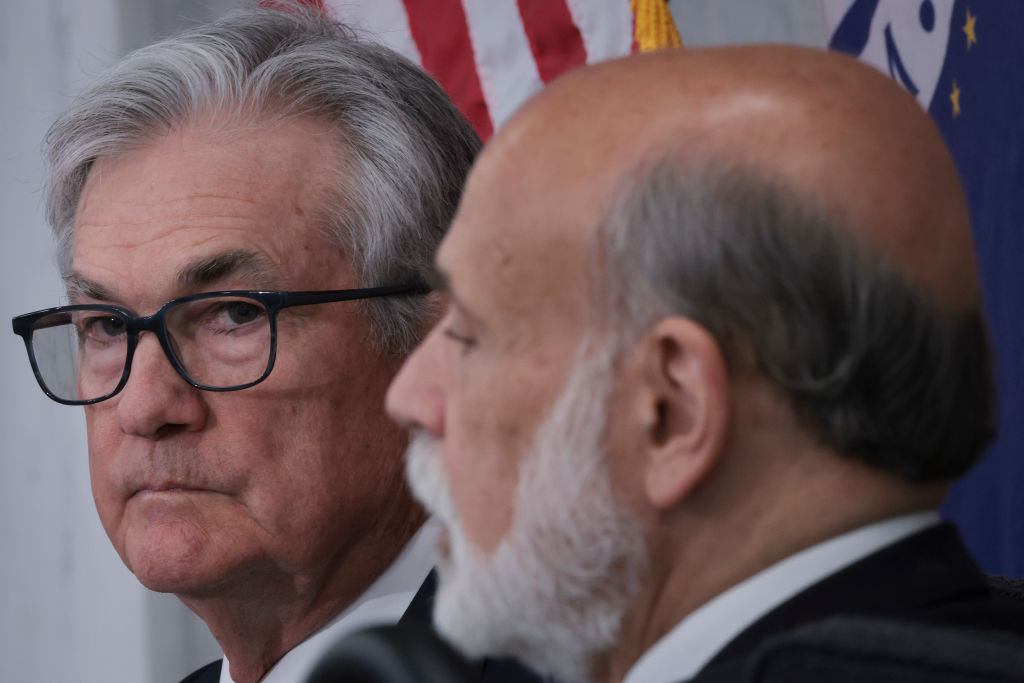Abbott and Costello. Laurel and Hardy. Jerome Powell and Ben Bernanke. Two Federal Reserve Chairs walk into a Perspectives on Monetary Policy panel discussion at the Thomas Laubach Research Conference, and one of them says, “Boy, the food here is too expensive.” And the other one says, “I know, and such small portions for more dollars.” Bernanke and Powell participated in a good old-fashioned and cozy tête-à-tête to discuss current events, mainly inflation and the banking turmoil. But while the two monetary policy legends blamed external factors for all the damage since the COVID-19 public health crisis, neither man looked into the soul of the Eccles Building to ascribe a modicum of blame.
A Federal Reserve Talk
There were two main headlines emanating from the May 19 Powell-Bernanke event. The first was that the current Fed chair does not believe interest rates may need to rise further as the credit crunch from the banking crisis might be enough to maintain inflation’s downward trajectory and achieve the institution’s 2% target rate. The second was that Bernanke seemed far more confident speaking to the audience than his colleague on stage, as Powell read primarily from several pieces of paper.
Throughout the hour-long talk, Bernanke and Powell highlighted the contributing factors to why price inflation reached a 40-year high, specifically referencing adverse supply shocks (energy and non-energy commodities, labor, and global supply chains). They also explained that financial institutions failed to prepare for a rising-rate environment as they hedged against risk by investing in long-duration bonds, resulting in chaos in the banking system.
So, in the end, according to Powell, restoring price stability and preparing for future supply shocks are essential for the Federal Reserve moving forward. Perhaps the incumbent chief central banker read from one of his previous speeches since these are the exact words uttered by Powell each time he appears in a public forum. But, unfortunately, neither man discussed the Fed’s role in facilitating the current mess in the economic landscape.
Blame the Fed

(Photo by Win McNamee/Getty Images)
In a little more than two years, the US money supply soared more than 40%, hitting $21.7 trillion. This occurred as the central bank slashed the benchmark fed funds rate to nearly 0%, increased the balance sheet to close to 9% as it went on a bond-buying spree, and initiated the pandemic-related emergency lending facilities. At the same time, the federal government approved trillions in new spending, outlays that were monetized by the world’s most powerful organization.
Despite being the smartest and most omnipotent men and women in the country, the monetary policymakers did not understand that when trillions in new money are injected into the economy while the nation is under lockdown, there will be an astronomical amount of dollars and cents chasing too few goods. Moreover, once conditions are normalized, acquiring the same amount of goods and services will take more currency units, be it for a carton of eggs or a hotel suite.
It was not only the Fed that embarked upon this reckless policymaking. Central banks worldwide employed the same instruments of financial destruction that decimated the citizenry’s purchasing power. Of course, officials will blame surging prices on Russian President Vladimir Putin’s invasion of Ukraine or mom-and-pop gasoline stations. But basic economics – and legendary economist Milton Friedman – tell us that inflationism is a “monetary phenomenon.” This is what Friedman wrote and explained in a lecture: “It is always and everywhere, a monetary phenomenon. It’s always and everywhere, a result of too much money, of a more rapid increase in the quantity of money than an output.”
Bernanke touched upon the oil shock in the 1970s as another example of a supply factor contributing to rampant inflation. However, he refrained from mentioning that then-Fed Chair Arthur Burns kept monetary policy conditions too loose for too long to ensure that President Richard Nixon won re-election. The American people were forced to pay for the guns and butter of the 1960s, primarily the costly Vietnam War and former President Lyndon Baines Johnson’s dramatic expansion of the state. The money supply spiked, and Burns slashed the policy rate on multiple occasions heading into 1972. The bills eventually came due as the consumer price index (CPI) skyrocketed, reaching close to 15% in the coming years, even with the altered CPI calculations. By the time Burns reacted by raising rates, it was a case of too little, too late. The inflation genie was out of the bottle.
 This little history lesson in Fed politics matters because Bernanke and Powell cannot even fathom that the printing press played a role in the Great Inflation or the current post-pandemic inflation wave.
This little history lesson in Fed politics matters because Bernanke and Powell cannot even fathom that the printing press played a role in the Great Inflation or the current post-pandemic inflation wave.
Fed Up
Although Powell and several Boards of Directors champion the diversity of views at the Federal Reserve, the policy directives prove that there is very little fundamental difference among the governors or even staff economists. Sure, there might be some disagreement on the size of a rate hike – 25 basis points or 50 basis points – but everyone shares the same meat and potatoes recipe. Judy Shelton, a Fed nominee of former President Donald Trump, could have proffered modest intellectual variety. But this proved to be too much for the central bankers. The Fed is a leviathan, a monolith, and a deity that can make or break economies, stock markets, and governments. Nobody can deviate from the standard playbook, which contains one move: money printer go brrrr.



